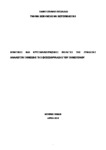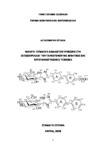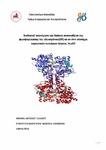| dc.creator | Chetter B.A., Kyriakis E., Barr D., Karra A.G., Katsidou E., Koulas S.M., Skamnaki V.T., Snape T.J., Psarra A.-M.G., Leonidas D.D., Hayes J.M. | en |
| dc.date.accessioned | 2023-01-31T07:45:22Z | |
| dc.date.available | 2023-01-31T07:45:22Z | |
| dc.date.issued | 2020 | |
| dc.identifier | 10.1016/j.bioorg.2020.104003 | |
| dc.identifier.issn | 00452068 | |
| dc.identifier.uri | http://hdl.handle.net/11615/72793 | |
| dc.description.abstract | Glycogen phosphorylase (GP) is an important target for the development of new anti-hyperglycaemic agents. Flavonoids are novel inhibitors of GP, but their mode of action is unspecific in terms of the GP binding sites involved. Towards design of synthetic flavonoid analogues acting specifically at the inhibitor site and to exploit the site's hydrophobic pocket, chrysin has been employed as a lead compound for the in silico screening of 1169 new analogues with different B ring substitutions. QM/MM-PBSA binding free energy calculations guided the final selection of eight compounds, subsequently synthesised using a Baker-Venkataraman rearrangement-cyclisation approach. Kinetics experiments against rabbit muscle GPa and GPb together with human liver GPa, revealed three of these compounds (11, 20 and 43) among the most potent that bind at the site (Ki s < 4 µM for all three isoforms), and more potent than previously reported natural flavonoid inhibitors. Multiple inhibition studies revealed binding exclusively at the inhibitor site. The binding is synergistic with glucose suggesting that inhibition could be regulated by blood glucose levels and would decrease as normoglycaemia is achieved. Compound 43 was an effective inhibitor of glycogenolysis in hepatocytes (IC50 = 70 µM), further promoting these compounds for optimization of their drug-like potential. X-ray crystallography studies revealed the B-ring interactions responsible for the observed potencies. © 2020 Elsevier Inc. | en |
| dc.language.iso | en | en |
| dc.source | Bioorganic Chemistry | en |
| dc.source.uri | https://www.scopus.com/inward/record.uri?eid=2-s2.0-85089093926&doi=10.1016%2fj.bioorg.2020.104003&partnerID=40&md5=f3d444afc333f3bb91d8f9a01c1d5466 | |
| dc.subject | bromine | en |
| dc.subject | cell extract | en |
| dc.subject | chlorine | en |
| dc.subject | chrysin | en |
| dc.subject | flavonoid | en |
| dc.subject | fluorine | en |
| dc.subject | glucose | en |
| dc.subject | glycogen phosphorylase | en |
| dc.subject | glycosyltransferase inhibitor | en |
| dc.subject | halogen | en |
| dc.subject | methyl group | en |
| dc.subject | quercetin | en |
| dc.subject | biological product | en |
| dc.subject | flavonoid | en |
| dc.subject | glycogen phosphorylase | en |
| dc.subject | allosteric site | en |
| dc.subject | animal tissue | en |
| dc.subject | Article | en |
| dc.subject | binding site | en |
| dc.subject | catalysis | en |
| dc.subject | computer model | en |
| dc.subject | conformational transition | en |
| dc.subject | crystal structure | en |
| dc.subject | cyclization | en |
| dc.subject | drug synthesis | en |
| dc.subject | enthalpy | en |
| dc.subject | ex vivo study | en |
| dc.subject | glucose blood level | en |
| dc.subject | glycogen synthesis | en |
| dc.subject | glycogenolysis | en |
| dc.subject | Hep-G2 cell line | en |
| dc.subject | human | en |
| dc.subject | human cell | en |
| dc.subject | human tissue | en |
| dc.subject | hydrophobicity | en |
| dc.subject | inhibition constant | en |
| dc.subject | ligand binding | en |
| dc.subject | liver | en |
| dc.subject | molecular mechanics | en |
| dc.subject | nonhuman | en |
| dc.subject | priority journal | en |
| dc.subject | quantum mechanics | en |
| dc.subject | ring opening | en |
| dc.subject | sequence homology | en |
| dc.subject | solvation | en |
| dc.subject | substitution reaction | en |
| dc.subject | surface area | en |
| dc.subject | X ray crystallography | en |
| dc.subject | animal | en |
| dc.subject | hyperglycemia | en |
| dc.subject | Leporidae | en |
| dc.subject | molecular model | en |
| dc.subject | non insulin dependent diabetes mellitus | en |
| dc.subject | procedures | en |
| dc.subject | structure activity relation | en |
| dc.subject | X ray crystallography | en |
| dc.subject | Animals | en |
| dc.subject | Biological Products | en |
| dc.subject | Crystallography, X-Ray | en |
| dc.subject | Diabetes Mellitus, Type 2 | en |
| dc.subject | Flavonoids | en |
| dc.subject | Glycogen Phosphorylase | en |
| dc.subject | Humans | en |
| dc.subject | Hyperglycemia | en |
| dc.subject | Models, Molecular | en |
| dc.subject | Rabbits | en |
| dc.subject | Structure-Activity Relationship | en |
| dc.subject | Academic Press Inc. | en |
| dc.title | Synthetic flavonoid derivatives targeting the glycogen phosphorylase inhibitor site: QM/MM-PBSA motivated synthesis of substituted 5,7-dihydroxyflavones, crystallography, in vitro kinetics and ex-vivo cellular experiments reveal novel potent inhibitors | en |
| dc.type | journalArticle | en |




